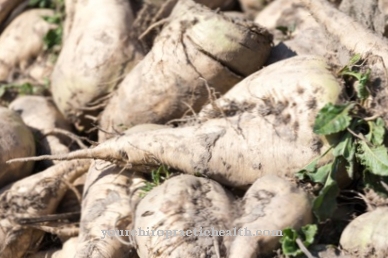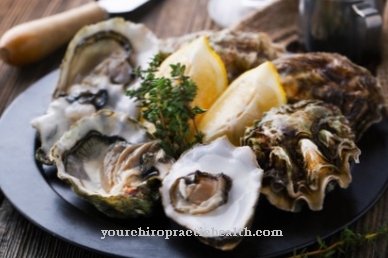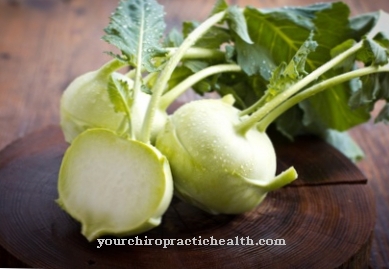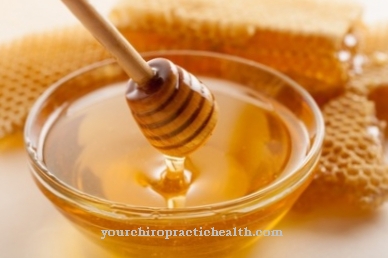Cut cabbage is a hardy leafy vegetable that is closely related to rapeseed. The fast-growing plant was widespread throughout northern Germany until the middle of the 20th century and was known under a variety of regional names. In the Bremen kitchen in particular, cut cabbage is traditionally prepared hearty with pee, but it can also be used as a salad.
What you should know about cut cabbage
Like rapeseed, which is related to it, cut cabbage is a cruciferous plant. This family of plants is represented with numerous subspecies in Central Europe and is used economically in many ways. The cut cabbage was also widespread until the 1950s, especially in northern Germany and there in the landscape around Bremen.
Cut cabbage is a hybrid of rapeseed and vegetable cabbage and can be grown all year round. Due to its insensitivity to frost, it is particularly suitable for cultivation in the cold season. In addition, cut cabbage thrives excellently even in nutrient-poor soils and does not require intensive care. The herbaceous plant only reaches a low height. Their oval to elongated, feathery notched leaves reach a length of 5 to 8 cm and are often slightly curled at the edge. Their color is usually a deep mid-green. The cabbage can be harvested just six to eight weeks after sowing. It used to be cut with a scythe in order to harvest it on larger acreages. This is where the name commonly used in Bremen derives Scheerkohl from.
In addition, there are other typical regional names for cut cabbage such as Cutting rep and Kohlreps. If the plant is left uncut, it will develop long stems with small yellow flowers similar to those of rapeseed. Apart from the long stems, the whole plant can be eaten. The young leaves taste very mild and sometimes even a little sweet with a slightly nutty and piquant undertone that is reminiscent of kohlrabi and rocket. Cabbage harvested later is much hotter with a kale-like taste. While young cut cabbage is very tender and can also be processed raw, the leaves become a bit leathery as they grow, so they have to be cooked before consumption.
The traditional preparation of cut cabbage is similar to that of spinach and is very hearty. However, cut cabbage can also be used in the light, modern kitchen without any problems. After this old vegetable was almost completely forgotten, it is now occasionally available again from regional suppliers.
Importance to health
Since cut cabbage is one of the few indigenous vegetables that also thrive in the cold season, it is a valuable source of vitamins during winter. Since it is particularly rich in vitamin C, consuming cut cabbage can strengthen the immune system and prevent colds.
Folic acid, which belongs to the group of B vitamins, is also found in comparatively high amounts in cut cabbage. Like the other B vitamins, folic acid is also of great importance for cell metabolism. It not only has a cell renewal effect, but also influences blood formation and thus the entire cardiovascular system. It is especially important for expectant mothers, which is why green vegetables such as cut cabbage are an important part of the diet during pregnancy. In addition, cut cabbage contains important minerals and trace elements that have a positive effect on blood formation, bone growth and metabolism.
The mustard oil, which provides a subtle spiciness, stimulates the circulation without stressing the body. It also has a slight antibacterial effect that can prevent infections and inflammation and support the immune system. The fiber contained in cut cabbage is also an important contribution to a healthy diet. Despite their low calorie content, they are filling and at the same time stimulate the gastrointestinal tract. This allows digestion to be regulated in a natural way. Since cut cabbage is a very light vegetable, it is a good accompaniment to hearty meals.
Ingredients & nutritional values
With only 25 kcal per 100 g, cut cabbage is one of the low-calorie local vegetables. It contains only small amounts of vegetable proteins and almost no fat. Cut cabbage, on the other hand, is very rich in vitamins and minerals. In addition to vitamins A and C, it mainly contains various vitamins from the vitamin B complex.
The calcium and iron content is also comparatively high. As with the closely related oilseed rape and various other cruciferous vegetables, cut cabbage also contains erucic acid, an unsaturated fatty acid, and mustard oil glycosides. These ensure the characteristic slight sharpness and the typical cabbage taste.
Intolerances & allergies
Cut cabbage is much more digestible than many other local vegetables. Allergies and intolerance to the plant itself are not known. However, if you have heart problems, you should be careful not to use stems that are too thick.
As with rape, cut cabbage contains erucic acid in older stalks, which in large quantities can cause fatty degeneration of the heart. Since the stalks of older cabbage leaves can taste unpleasantly bitter, they are usually removed before preparation anyway. If you have an existing allergy to mustard, which also belongs to the cruciferous family, you should consult your doctor before consuming cut cabbage.
Shopping & kitchen tips
Although cut cabbage has been grown again in recent years, it is still extremely rarely available. In normal supermarkets it is usually not offered at all, and even in weekly markets and in special vegetable stores it is not often found, as it is very sensitive to transport and becomes unsightly after a few days.
It is therefore advisable to purchase cut cabbage directly from a local supplier. Organic farmers and supporters of the slow food movement in particular are now preferring to use old local vegetables again. If you have your own garden, you can easily grow cabbage yourself. The corresponding seed can be obtained from specialized online retailers. Cut cabbage can be stored for two to three days in the fridge's vegetable compartment. However, it should be processed quickly, as the leaves wilt quickly after harvest. If possible, only the required amount of cut cabbage should be harvested or bought.
Preparation tips
Traditionally, cut cabbage is prepared like leaf spinach. After thorough washing and draining, the leaves are poured into glassy steamed onion cubes in a pan and briefly braised. It is only seasoned with salt and pepper. Hearty North German specialties such as pee go well with this.
Thanks to its mild and unobtrusive taste, cut cabbage can also be used in soups and stews or combined with Mediterranean vegetables and spices. It is particularly suitable as a filling for cannelloni, for example. Young cabbage can also be cut into strips and prepared as a salad.













.jpg)

.jpg)
.jpg)











.jpg)